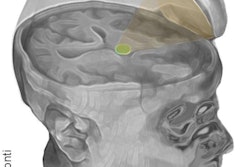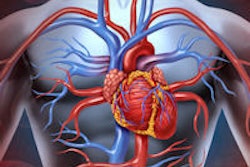
NEW YORK CITY - A focused cardiac ultrasound (FOCUS) examination can produce a faster and more accurate diagnosis for the difficult case of thoracic aortic dissection, also known as the "Great Masquerader," according to research presented at the American Institute of Ultrasound in Medicine (AIUM) annual meeting.
In a retrospective study, researchers from Yale University found that patients who had received emergency physician-performed FOCUS had no missed thoracic aortic dissections, while nearly half of a patient cohort who didn't receive the echocardiography study had a missed dissection.
What's more, those patients who received FOCUS exams had a significantly faster time to diagnosis, according to Dr. Joseph Pare, who presented the group's research during a Saturday morning scientific session.
The Great Masquerader
Thoracic aortic dissection is known as the "Great Masquerader" due to its challenging diagnosis, Pare said.
"Unfortunately, there is often misdiagnosis, which often leads to significant, significant malpractice claims with high payouts," he said.
Another problem is that current screening methods such as patient history, physical exam findings, and chest x-ray/electrocardiogram (ECG) are poor screening tools, he said.
In 2010, the American Heart Association released recommendations for how to decide on imaging for suspected thoracic aortic dissection. For many patients, under that three-point scoring system, it would come down to a chest x-ray finding of a wide mediastinum to move on to additional imaging, according to Pare.
"Otherwise, if it's based on hypotension or physician gestalt it could also go on to imaging," he said.
An improved diagnosis?
The Yale researchers believed that echocardiography would be better at diagnosing an abnormal aorta, leading to an improved diagnosis for thoracic aortic dissection. They sought to determine if a FOCUS study could yield a one-hour reduction in the time it took to diagnose patients with ascending thoracic aortic dissection, and they also wanted to find out if FOCUS reduces associated mortality, misdiagnosis, and time to disposition.
The retrospective cohort analysis involved patients screened at one of the institution's three emergency departments (EDs) between March 1, 2013, and May 1, 2015. All FOCUS images were stored as DICOM images, and all EDs at Yale utilized Epic electronic health record software (EHR) from Epic Systems, Pare said. The researchers reviewed the EHR for all records of patients who had been diagnosed with aortic dissection and also reviewed autopsy records.
For the purposes of the study, a thoracic aorta measurement of more than 4.6 cm was considered to be abnormal. Of the 32 patients included in the study, 16 received FOCUS while 16 did not.
Of the 16 who did receive FOCUS, 13 had an aortic measurement of at least 4 cm on subsequent CT angiography (CTA), two had an aortic diameter measurement of less than 4 cm on CTA, and one had no measurement available for comparison.
Of the 13 who had an aortic diameter of at least 4 cm on CTA, ultrasound had the same measurement in 10 cases and had a measurement of less than 4 cm in two cases. One case did not have a measurement available for comparison.
For the two patients who had an aortic diameter measurement of less than 4 cm, one had the same measurement on ultrasound and one did not have an aortic diameter measurement.
Outcome measures
FOCUS missed no dissections in the group of 16 patients, while the group of 16 patients who did not receive the FOCUS study had seven missed dissections (43.8%) of 16. That difference was statistically significant (p = 0.007).
In addition, the median time to diagnosis was 80 minutes (range, 46-157) in the patient cohort who received FOCUS exams, compared with 226 minutes (range, 109-1,449) for those who didn't receive the study. That difference also reached statistical significance (p = 0.0075).
Five of the 16 patients who received FOCUS died, compared with six of the 16 who did not receive FOCUS exams. The difference was not statistically significant.
However, when looking at the number of patients who died without a do-not-resuscitate order, that number dropped to two of 13 for the FOCUS patient cohort. The same six of 16 would have died in the non-FOCUS group.
"Death was not an outcome measure that was [significantly] different between the two groups, but in a larger group I anticipate it would have been," Pare said.
The median time to disposition was 134 minutes (range, 101-195) in the group of patients who received FOCUS, compared with 205 minutes (range, 114-342 minutes) in the group of patients who did not. That difference was not statistically significant, Pare said.
The researchers noted that 93.5% of thoracic aorta dissections in the study had an aorta larger than 4 cm. A FOCUS measurement of greater than 4 cm would have identified 71.4% of patients with thoracic aorta dissections.
FOCUS also likely outperforms other evaluations currently used to screen patients for thoracic aorta dissections, such as aortic insufficiency, pulse deficit, wide mediastinum, abnormal aortic contour, and ECG findings, Pare said.
"There may be some concerns that we're identifying a lot of abnormal [FOCUS studies] that are going to lead to a lot of unnecessary tests," he said. "But other research has been done that shows emergency-physician performed [FOCUS] for evaluation of the proximal aorta actually has very high specificity."




















